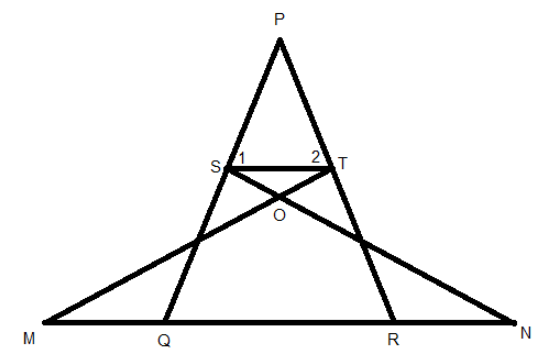
In given figure


Answer
494.7k+ views
Hint:
We can equate the corresponding sides of congruent triangles. Then we can equate the sides opposite to equal angles in a triangle. From these two relations, we can show that 2 sides are proportional. Then we can take the common angle of the triangles. Using these conditions, we can prove the required triangles are similar.
Complete step by step solution:
Consider the triangle PST,
It is given that
We know that in a triangle, the sides opposite to equal angles will be equal.
So, from the figure, we can write,
It is given that
We know that corresponding sides of congruent triangles are equal.
Now we can add equations (2) and (1).
From the figure, we can write,
Now we can consider the triangles PTS and PRQ.
We can consider the angles
From the figure, they represent the same angles. So, they will be equal.
Now consider the sides PS and PQ. We can take their ratio.
Now we can apply equations (1) and (3). Then we get,
So, the 2 sides are proportional.
As the 2 sides are proportional and the corresponding angle between them are equal, we can say that the triangles PTS and PRS are similar.
So, we get,
Hence proved.
Note:
Note: Alternate solution is given by,
Consider the triangle PST,
It is given that
We know that in a triangle, the sides opposite to equal angles will be equal.
So, from the figure, we can write,
It is given that
We know that corresponding sides of congruent triangles are equal.
Now we can add equations (a) and (b).
From the figure, we can write,
PQ and PR are sides of the triangle PQR and are equal. Then the opposite angles will be equal.
Consider the triangles PTS and PRQ
By taking the angle sum property we get,
On rearranging and applying the given condition, we get,
On rearranging and substituting (d), we get
On comparing (e) and (f), we get,
On substituting, equation (d) and given condition, we get,
Now we can consider the triangles PTS and PRQ.
We can consider the angles
From the figure, they represent the same angles. So, they will be equal.
From the above results, we can write,
As the corresponding angles are equal, we can say that the triangles PTS and PRS are similar.
So, we get,
Hence proved.
We can equate the corresponding sides of congruent triangles. Then we can equate the sides opposite to equal angles in a triangle. From these two relations, we can show that 2 sides are proportional. Then we can take the common angle of the triangles. Using these conditions, we can prove the required triangles are similar.
Complete step by step solution:
Consider the triangle PST,
It is given that
We know that in a triangle, the sides opposite to equal angles will be equal.
So, from the figure, we can write,
It is given that
We know that corresponding sides of congruent triangles are equal.
Now we can add equations (2) and (1).
From the figure, we can write,
Now we can consider the triangles PTS and PRQ.
We can consider the angles
From the figure, they represent the same angles. So, they will be equal.
Now consider the sides PS and PQ. We can take their ratio.
Now we can apply equations (1) and (3). Then we get,
So, the 2 sides are proportional.
As the 2 sides are proportional and the corresponding angle between them are equal, we can say that the triangles PTS and PRS are similar.
So, we get,
Hence proved.
Note:
Note: Alternate solution is given by,
Consider the triangle PST,
It is given that
We know that in a triangle, the sides opposite to equal angles will be equal.
So, from the figure, we can write,
It is given that
We know that corresponding sides of congruent triangles are equal.
Now we can add equations (a) and (b).
From the figure, we can write,
PQ and PR are sides of the triangle PQR and are equal. Then the opposite angles will be equal.
Consider the triangles PTS and PRQ
By taking the angle sum property we get,
On rearranging and applying the given condition, we get,
On rearranging and substituting (d), we get
On comparing (e) and (f), we get,
On substituting, equation (d) and given condition, we get,
Now we can consider the triangles PTS and PRQ.
We can consider the angles
From the figure, they represent the same angles. So, they will be equal.
From the above results, we can write,
As the corresponding angles are equal, we can say that the triangles PTS and PRS are similar.
So, we get,
Hence proved.
Recently Updated Pages
Master Class 9 General Knowledge: Engaging Questions & Answers for Success

Master Class 9 English: Engaging Questions & Answers for Success

Master Class 9 Science: Engaging Questions & Answers for Success

Master Class 9 Social Science: Engaging Questions & Answers for Success

Master Class 9 Maths: Engaging Questions & Answers for Success

Class 9 Question and Answer - Your Ultimate Solutions Guide

Trending doubts
Fill the blanks with the suitable prepositions 1 The class 9 english CBSE

Difference Between Plant Cell and Animal Cell

Given that HCF 306 657 9 find the LCM 306 657 class 9 maths CBSE

The highest mountain peak in India is A Kanchenjunga class 9 social science CBSE

What is the difference between Atleast and Atmost in class 9 maths CBSE

What is pollution? How many types of pollution? Define it




